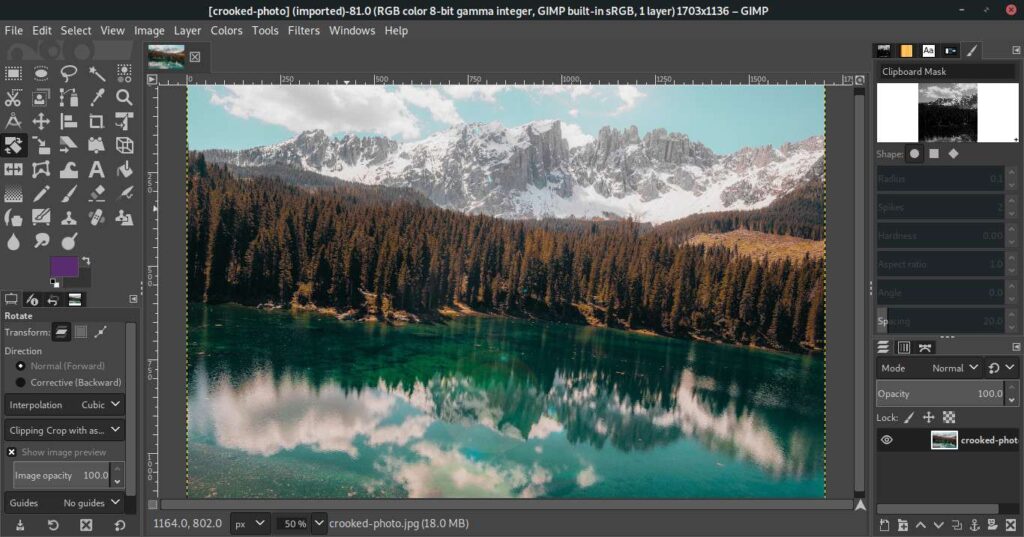What is GIMP
GIMP (GNU Image Manipulation Program) is a free, open source raster graphics editor that can be used for image editing and photo retouching, creation of digital art, and more. GIMP provides a robust toolset including layers, selection tools, filters, transformation tools, painting brushes, and color adjustment options.
It has a highly customizable interface and supports extensive automation through scripting. Key features include support for a wide array of image file formats, color management support, graphic tablet pressure sensitivity, non-destructive editing via layers, and powerful batch processing capabilities.
Extensibility is enabled via plugins like GIMP Animation Package. GIMP offers a free photoshop alternative for individuals and small businesses to fulfill a wide range of image manipulation needs and creative projects.

Technical characteristics
- Architecture – Is the application 32-bit, 64-bit, or available for multiple architectures? This determines compatibility.
- Platform/OS – What operating systems are officially supported? Examples – Windows, MacOS, Linux, iOS, Android.
- Programming languages – What languages is the software written in? This can indicate reliability and speed.

Features
Advantages
- Regular updates – Vendors continuously add new features and improvements.
- Customizability – Tailor application to match unique workflows.
- Security – application offers access controls, encryption, permissions.
- Disaster recovery – Data is stored securely online or in multiple locations.
- Competitive advantage – Innovative application can help businesses differentiate.
Disadvantages
- Dependence – Relying too much on application creates risks if systems fail.
- Vendor lock-in – Difficulty switching providers due to data/process integration.
- Inflexibility – Inability to modify standardized application for unique needs.
- Migration issues – Moving data between application versions or tools can be challenging.

What’s new
- New transformation tools – Recent GIMP versions have added or improved tools like the Perspective Clone tool, Warp Transform tool, and Cage Transform tool.
- GPU/OpenCL support – Utilizing the GPU for operations like painting and applying filters can accelerate workflows (currently experimental).
- Dark theme/UI refresh – Interface refinements like support for dark themes and UI scaling were added.
System Requirements GIMP latest version
- Operating System: GIMP runs on Linux, Windows, and macOS. The latest versions it supports are Windows 7 and newer, macOS 10.10 Yosemite and newer, and Linux with GTK+ 3.22 and newer.
- Processor: An Intel Pentium 4, Apple Silicon, or better processor is recommended.
- RAM: Minimum of 2GB RAM is required, but 4GB or more is recommended for complex work with high-resolution images.
- Storage: At least 200MB of available space is needed, but additional free space is recommended for working with large image files.

How to download GIMP
You can download DIMP on our website, click the “Download GIMP” button at the bottom of this page.
On the next page, click the “Download GIMP for Windows” button. This will download the latest stable installer.
Once downloaded, run the installer executable and follow the setup wizard. Accept the default options.
After installation, GIMP can be launched from the Start menu.
Activation keys [source for version]
- O4S8A-29IJ7-369TK
- NT7MC-68S4G-5P8H5
- MF454-JH786-P67H6
- 5561F-66IH7-DA3GN

Alternative software
- Pixlr – Browser-based editing app that is fully featured for quick image edits and tweaks without installing anything.
- Paint.NET – Popular basic image editor for Windows. Fewer features than GIMP but very easy to use interface.
- PhotoScape – Full featured photo editor for Windows with fun filters and effects. Good for casual users.

FAQ
A: GIMP supports a wide variety of image formats including JPEG, PNG, GIF, TIFF, PSD, BMP and more. You can work with photos, computer generated images, icons, logos, or any other raster-based image.
A: Yes, GIMP has painting and drawing tools such as brushes, pencils, clone stamp, and various filters that can help create artistic illustrations from scratch. It supports graphics tablets for natural drawing.
A: GIMP is primarily focused on image manipulation and does not have built-in features for editing videos. However, its animation package add-on can create animated GIFs from layers. For full video editing, a dedicated video editor like Kdenlive, Shotcut or OpenShot is recommended.
Conclusion
In conclusion, GIMP is a powerful image editing software that offers a wide range of features and functions. It is an open-source and free software program, meaning anyone can use it without any cost. GIMP provides users with access to its source code, allowing them to modify and customize the program according to their needs.

This open-source nature promotes a collaborative community, where developers can contribute and improve the software continuously. GIMP also benefits from the open-source community by being able to leverage existing libraries and code from other projects, reducing the dependency on proprietary software.
Overall, GIMP is a valuable tool for graphic designers, photographers, and anyone seeking to edit images or create digital artwork. With its code-free setup, users can easily install and start using GIMP without any technical knowledge or expertise.
